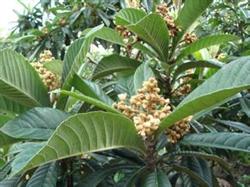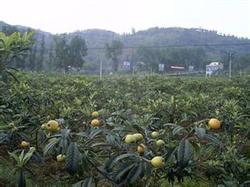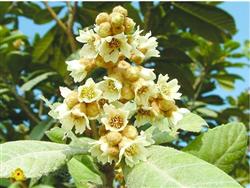Do a good job in postharvest management of loquat to ensure a good harvest in the coming year

Loquat is basically picked in May, and postharvest production management is directly related to tree potential growth and next year's fruit. The postharvest production management of loquat should be carried out mainly from three aspects: fertilization, pruning and pest control. Adequate postharvest fertilizer loquat should be fertilized in time to promote the development of summer shoots after harvest, with nitrogen fertilizer as the main fertilizer, combined with phosphorus and potassium fertilizer, and sufficient fertilizer should be applied, accounting for about 50% of the total fertilizer used in the whole year. It is necessary to grasp the following three principles in fertilization technology: first, to make a reasonable combination of nitrogen, phosphorus, potassium and other nutrient elements according to the actual needs of loquat growth and development; second, to apply more organic fertilizer and compound fertilizer as much as possible. Organic fertilizer should be stacked and fermented for a certain period of time to remove organic acid and harmful gases and eliminate bacteria, insect eggs and weed seeds. Organic compound fertilizer and multi-component compound fertilizer should be selected. Third, select high-quality chemical fertilizer to prevent the toxicity or influence of biuret in urea, heavy metals in phosphate fertilizer, chloral and chloride residues in potassium chloride on loquat. Pruning in time can not only restore the tree potential quickly, but also promote the summer shoots germinated before late July and lay the foundation for high quality and high yield in the coming year. The amount of pruning in summer does not exceed 20% of the total branches, sawing off 1-2 upright branches in the upper part of the crown, not sawing too many at a time, sawing off year by year, leading to a decrease in the height of the crown. The fruiting branches far away from the main branches should be retracted and pruned, and the retracted branches should be kept at the base of 10-15 cm and sawed diagonally to promote new shoots. In the hollow part of the crown, short truncation and long branches were used to cultivate the fruiting branches with large backbone branches. The fruiting branches after fruit harvest should be retained as far as possible, except those that are weak, so that they can germinate and bear fruit. The main postharvest diseases of loquat are stem rot and leaf spot branch rot, which is also commonly known as "rotten foot disease". If fruit trees show soft rot in the trunk of root neck at high humidity, or when the sap flows vigorously, the phenomenon of gum flow occurs, and the bark cracks and warps and peels off during drying, then it is likely to suffer from "rotten foot disease". In addition to strengthening cultivation and fertilizer and water management, the prevention and control methods should also be scraping off the disease spots, requiring scraping, burning the scraped bark on the spot, and applying medicament to promote wound healing under the guidance of experts. Leaf spot is also a key disease for control. Leaf spot is the general name of gray spot, spot and corner spot. It is the main disease of loquat. The light disease affects the tree potential, the heavy leaf becomes ossified and smaller, the leaves fall early and withered branches, and the plant growth weakens and reduces yield. In addition to improving the management level of the orchard, strengthening the tree potential and improving the disease resistance of the tree itself, 65% mancozeb 500-600 times solution or 80% Dasheng Mmur45 wettable powder 600 times solution was used after fruit picking to the summer shoot sprouting or early sprouting, which has the effect of preventing the disease. After fruit picking to pre-pregnant bud, the use of 0.3-0.5% Bordeaux solution and Baume 0.3-0.5 degree stone sulfur mixture can not only prevent disease, but also supplement loquat with copper and calcium, or 50% carbendazim wettable powder 800 times, or 70% methyl topiramate 600 times, and so on. The main postharvest pests of loquat are yellow caterpillar and longicorn beetle, also known as "yellow spicy worm" and "hairy insect". The larvae harm tender shoots and leaves. The main control method in summer and autumn is to spray rosin 16-20 times, which can not only kill the larvae of yellow caterpillar, but also kill lichens and moss on branches; it can also be sprayed with 5% fipronil 1500 times, or 50% phoxim 1000 times. Longicorn beetles are mainly brown longicorn beetles, longicorn beetles, etc., which are omnivorous pests. The control methods are mainly to find adults and kill them in loquat orchards in the morning and evening; to catch larvae in the tunnel with steel hooks; to soak cotton with 90% trichlorfon crystal 20 times liquid, and to plug them into fresh fecal holes, apply soil externally, and suffocate larvae.
- Prev

Key points of loquat cultivation techniques in spring and summer in South China
The cultivation and management of loquat in spring and summer in southern China is very important, which has a great influence on the yield and quality of loquat. Only by conscientiously doing a good job in loquat cultivation and management, fertilizing, pest control, flower and fruit thinning and fruit bagging, loquat not only has high yield, good quality, low pesticide residue and low pesticide residue.
- Next

Manage the loquat tree after Xiehua in early spring
First, apply stable fruit fertilizer. When the young fruit of loquat appeared after flowering, stable fruit fertilizer was applied, mainly instant nitrogen, phosphorus and potassium complete fertilizer. For fruit trees more than five years old, 1.5 kilograms of nitrogen, phosphorus and potassium compound fertilizer was applied to each tree, or 40 kilograms of mature human and animal manure water was retted. Second, prevention and control of diseases and pests. When the young fruit appears after the loquat blossoms,.
Related
- Moge, come on! The staff of the peasant association in the producing area of cantaloupe were frightened when the crowd gathered.
- Causes and Solutions of low Fruit setting rate of Apple
- Symptoms and control measures of passion fruit virus disease
- Fruit growing lesson: how do apple orchards keep high yields?
- Can you build orchards in the mountains? What are the pros and cons?
- How to manage the coloring period of Crisson grape?
- This paper introduces the processing technology of two kinds of fig products.
- How much is a month for retired teachers in rural areas by 2020?
- How can strawberry planting increase sugar content? We should pay attention to management in many aspects.
- What are the cultivation techniques on how to improve the yield of golden fruit?

